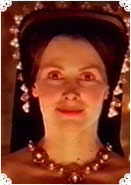Anne Boleyn

Anne Boleyn grew up in the family home of Hever Castle, the daughter of a courtier and diplomat. Her father, Sir Thomas Boleyn, was ambitious for her future. When Anne was 12 she left to continue her education in one of the centres of European culture – the court of the Archduchess Margaret, in the Netherlands. Anne was as ambitious to become a star in the English court.
When Anne returned to England, more French than English, she became a lady in waiting to Queen Catherine. Although not a noted beauty, Anne was chic and expert in intrigue and seduction. She encouraged Henry's attentions, while refusing to become his mistress. She knew her sister Mary had surrendered quickly, and been discarded just as swiftly.
During 1526, with Henry driven wild by her on-off tactics, she played her trump card – she would become Henry's wife, not mistress. However the necessary divorce from Catherine was not so easy: the inquiry by Cardinal Campeggio, the Pope's special envoy, could not reach the conclusion that Henry wanted.
In the towns and villages of England Anne was reviled as a gold digger and a heretic. But with a controversial new book, William Tyndale’s Obedience of a Christian Man, she strengthened her hold on Henry. This argued that authority over the Church properly belonged not to the Pope but to the king.
At the beginning of 1531 under heavy pressure from the king, the English clergy gave Henry a new title – Supreme Head On Earth Of The Church Of England In So Far As The Law Of Christ Allows. As such Henry would be able to grant himself a divorce. But in defying Rome he needed the support of King Francis I of France.
Six years after first insisting on being Henry’s wife, Anne finally married him. She was 32 years old and already pregnant.
The Spanish ambassador called for a military invasion of England to save the Christian religion, but Catherine herself would not act against her husband or bring bloodshed on her English people. Meanwhile, Henry’s Archbishop of Canterbury, Thomas Cranmer, declared Henry’s marriage to Anne valid.
On 1 June 1533 Queen Anne was crowned, to the outrage of the Pope who declared Cranmer’s judgments void and excommunicated Henry.
Although Anne gave birth to a daughter Elizabeth, not a son, the law was changed by the Act of Succession which declared Henry’s marriage to Catherine was declared ‘utterly void and annulled’ and affirmed his marriage to Anne and the rights of their children.
But when Anne miscarried, a new note of mistrust crept into the royal marriage. Another still birth followed.
Anne refused to make the transition from feisty mistress to obedient wife and her unpopularity among the masses was growing with their unease at religious and political changes. Her radical religious beliefs were also bitterly opposed by conservatives and churchmen.
After another miscarriage, the need for sons put remarriage back on the agenda. A more final solution than divorce was needed and the king’s minister Thomas Cromwell decided to use Anne's own sexual weapons against her.
Adultery in a queen was treason and Cromwell found evidence of a possible affair between Anne and a musician. Stories of further affairs began to surface.
Under torture the musician ‘confessed’. Over the next few days other arrests followed, including Anne’s own brother Lord Rochford.
Anne was tried by a jury of noblemen, presided over by her own uncle, the Duke of Norfolk. She was sentenced to be beheaded or burned, her marriage to Henry declared invalid and Elizabeth a bastard. The king's new love, Jane Seymour, was waiting impatiently to become queen.

0 Comments:
Post a Comment
<< Home